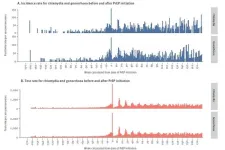(Press-News.org) In their research article published in Eurosurveillance, von Schreeb et al. challenge existing assumptions regarding the relationship between the use of HIV pre-exposure prophylaxis (PrEP) and the incidence of bacterial sexually transmitted infections (STI). According to the concept of sexual risk compensation, the start of PrEP treatment – a drug regimen which effectively prevents acquiring HIV – is associated with rises in STI as people feel protected against HIV while using it. However, von Schreeb et al. argue that available studies that have looked into the empirical foundation for the concept of sexual risk compensation related to PrEP use, have reported mixed results.
And while von Schreeb et al. also describe an increase in overall STI incidence linked to PrEP use during their study in the Danish capital region [1], they claim that the association “is not indicative of risk compensation”.
Looking into causality of PrEP initiation and STI incidence
The specific Danish setting with a unique civil registration number of the study participants in combination with comprehensive databases of STI test results for incidence data both before and after PrEP initiation, provided a data infrastructure for this study that allowed the researchers to investigate the timing of changes in STI incidence in relation to PrEP initiation, in order to investigate possible causality.
In their prospective cohort study with 1,494 participants (99% self-reported cismen and less than 1% transgender or non-binary) from the Danish capital region, 1,326 started PrEP during the study period and had at least one follow-up STI test, with the majority of the participants being on a daily treatment regimen (only 0.6% on-demand PrEP use).
Von Schreeb et al. compared STI incidence before and after the initiation of PrEP and in their cohort, PrEP use was linked to a more than twofold increase in the incidence of chlamydia, gonorrhoea and syphilis: during the observation time and prior to starting PrEP, the incidence rate of any STI (gonorrhoea, chlamydia or syphilis) was 35.3 per 100 person-years, equivalent to 708 STI diagnoses, and the incidence rate rose to 81.2 STIs per 100 person-years (1,849 diagnoses) during reported use of the treatment.
Changes in sexual risk-taking lead people to PrEP
Overall, PrEP was associated with a 35% higher risk of contracting any STI, which is consistent with findings from similar studies. The authors note that in Denmark, increases in STIs associated with PrEP start are associated to both older and younger individuals.
However, the authors highlight that their data indicate the detected rise in STI incidence happened before PrEP treatment was started, at around 10–20 weeks prior to it. This leads to their hypothesis that “if risk compensation was valid, we would expect STI incidence to increase when people feel protected against HIV. This increase could occur either immediately following the initiation of PrEP, or gradually over time, as they become more assured of the treatment’s protective effect. As no such increase was seen, an alternative interpretation to the association between PrEP and STIs is that changes in sexual risk-taking lead people to PrEP.”
Von Schreeb et al. conclude, based on their study results, that the “findings suggest that individuals frequently seek PrEP during periods when they are at increased risk of contracting STIs. This makes PrEP programmes a critical point of intervention, both for preventing HIV and STIs.”
----Ends----
References/notes to editors:
[1] von Schreeb Sebastian, Pedersen Susanne Kriegel, Christensen Hanne, Jørgsensen Kristina Melbardis, Harritshøj Lene Holm, Hertz Frederik Boetius, Ahlström Magnus Glindvad, Lebech Anne-Mette, Lunding Suzanne, Nielsen Lars Nørregaard, Gerstoft Jan, Kronborg Gitte, Engsig Frederik N. Questioning risk compensation: pre-exposure prophylaxis (PrEP) and sexually transmitted infections among men who have sex with men, capital region of Denmark, 2019 to 2022. Euro Surveill. 2024;29(13):pii=2300451. https://doi.org/10.2807/1560-7917.ES.2024.29.13.2300451
[2] von Schreeb et al. on (sexual) risk compensation: “Superficially, risk compensation could be understood as the notion that people are more cautious when facing high risks, and less cautious when facing low risks. If PrEP lowers the fear of HIV, people may relax their safety practices. However, the definition of risk compensation, rooted in the psychological theory of risk homoeostasis, extends beyond this straightforward notion. Risk compensation means that any reduction in risk will be completely counterbalanced by riskier behaviour, maintaining an individual's risk set point. As a consequence, preventive interventions will be inherently ineffective.
[3] Pre-exposure prophylaxis (PrEP) is the use of an antiretroviral medication by people who are HIV negative, to prevent their acquisition of HIV. The efficacy of PrEP is well-documented. ECDC released an opinion in 2015, that EU Member States should consider integrating PrEP into their existing HIV prevention package for those most at risk of HIV infection. WHO also recommended that PrEP should be offered as an additional prevention option for people at substantial risk of HIV infection based on the results of these trials. See also: https://www.ecdc.europa.eu/en/infectious-disease-topics/z-disease-list/hiv-infection-and-aids/prevention-and-control/hiv and https://www.ecdc.europa.eu/en/news-events/pre-exposure-prophylaxis-hiv-prevention-priorities-action-european-region
END
Exploring the relationship between HIV pre-exposure prophylaxis and the incidence of chlamydia, gonorrhea and syphilis – findings from Denmark
Does use of HIV pre-exposure prophylaxis (PrEP) lead to more sexual risk-taking or is taking sexual risks the reason that makes people use PrEP? Von Schreeb et al. present findings from Denmark, challenging the concept of sexual risk compensation
2024-03-28
ELSE PRESS RELEASES FROM THIS DATE:
Music: Song lyrics have become simpler and more repetitive since 1980
2024-03-28
We have been alerted to a potential error in some of the coding used by the authors in their analyses and are looking into this as a matter of urgency. The authors are confident that the main findings of the paper will remain unaltered, however some aspects may be affected and we have removed two sentences from the press release to reflect this. We will provide an update if there are further developments. We apologise for any inconvenience caused.
The lyrics of English-language songs have become simpler and more repetitive over the past 40 years, according to a study published in Scientific Reports.
Eva Zangerle and ...
Environment: More than half of Colorado River’s water used to irrigate crops
2024-03-28
Irrigation for agriculture uses more than half of the Colorado River’s total annual water flow, reports a paper published in Communications Earth & Environment. This finding is part of a new comprehensive assessment of how the Colorado River’s water is consumed — including both human usage and natural losses — and provides a more complete understanding of how the river’s water is used along its over 2,300 km (almost 1,500-mile) length.
The Colorado River flows through the southwestern United States (including the Grand Canyon) and northwestern Mexico whilst supplying water to more than 40 million people and more than 2 million ...
When inequality is more than “skin-deep”: Social status leaves traces in the epigenome of spotted hyenas in Tanzania
2024-03-28
A research consortium led by scientists from the Leibniz Institute for Zoo and Wildlife Research (Leibniz-IZW) provide evidence that social behaviour and social status are reflected at the molecular level of gene activation (epigenome) in juvenile and adult free-ranging spotted hyenas. They analysed non-invasively collected gut epithelium samples from both high-ranking and low-ranking female hyenas and showed that rank differences were associated with epigenetic signatures of social inequality, i.e., the pattern of activation or switching off of genes that regulate important physiological processes such as energy conversion and immune response ...
Study explores the future of at-home cancer treatment
2024-03-28
LOS ANGELES — A clinical trial from Keck Medicine of USC will test the feasibility of treating non-small cell lung cancer with immunotherapy provided at home.
Immunotherapy, medicines that use the body’s immune system to eliminate or control cancer cells, are effective for many cancer patients, but are currently only administered intravenously (into the vein) in a doctor’s office or hospital.
The study will examine if a new formulation of atezolizumab, an immunotherapy approved for treating certain types of non-small cell lung cancer, can instead be safely and effectively ...
First performance standards published to measure the effectiveness of lifestyle medicine treatments
2024-03-28
An expert panel has published the first performance measures to identify remission and evaluate the effectiveness of lifestyle medicine treatments, which will allow more objective comparisons between lifestyle behavior interventions and other non-lifestyle treatments.
The performance measures are significant because, as interest in the field of lifestyle medicine has grown, it became clear that the lack of standards to document remission or long-term progress following lifestyle medicine treatment was a barrier to the widespread integration of the ...
To keep volunteers, connect them
2024-03-28
At a time when America needs volunteers more than ever, to tackle social problems from homelessness to disaster recovery, fewer people have been volunteering.
The number of volunteers for nonprofit and community-based organizations declined recently for the first time in decades, from 30% of the population in 2019 to 23% in 2021. That’s according to AmeriCorps and the U.S Census Bureau, which have tracked rates of volunteerism since 2002.
New research from Yifan Yu, assistant professor of ...
Suppressing boredom at work hurts future productivity, study shows
2024-03-28
Boredom is more common at work than in any other setting, studies show, and employees are bored at work for more than 10 hours per week on average.
Even astronauts and police officers get bored on the job. No occupation is immune.
Boredom serves an important purpose — it signals the need to stop an action and find an alternative project. But boredom becomes problematic when it’s ignored.
New research from the University of Notre Dame shows that trying to stifle boredom prolongs its effects and that alternating boring and meaningful tasks helps to prevent the effects of one boring task from ...
Older brain cells linger unexpectedly before their death
2024-03-28
For oligodendrocytes—the central nervous system cells critical for brain function—age may not bring wisdom, but it does come with the power to cling to life for much, much longer than scientists knew. That's according to a new study featured on the March 27 cover of the Journal of Neuroscience.
Mature oligodendrocytes took a shocking 45 days to die following a fatal trauma that killed younger cells within the expected 24 hours, Dartmouth researchers report. The findings suggest there's a new pathway for efforts to reverse or prevent the damage that aging and diseases such as multiple sclerosis cause to these important cells.
In the brain, ...
Clear shift in arterial diseases in diabetes
2024-03-28
There has been a redistribution in the risk of arterial disease in type 1 and 2 diabetes. The risks of heart attack and stroke have decreased significantly, while complications in more peripheral vessels have increased in relative importance, according to studies at the University of Gothenburg.
It is well known that type 1 and 2 diabetes increase the risk of heart attack and stroke. Previous research has also identified the clearest cardiometabolic risk factors in this context, such as obesity, lipid disorders, and high blood pressure.
How diabetes and cardiometabolic risk factors affect blood ...
Celebrating half a century of pioneering excellence: EBMT marks its 50th anniversary
2024-03-28
Barcelona, 27 March 2024 – The EBMT proudly commemorates its 50th anniversary, marking five decades of transformative advancements in the field of hematopoietic cell transplantation (HCT) and cellular therapy. More than 5,000 healthcare professionals will gather from the 14th to the 17th of April, 2024, at the Scottish Event Campus in Glasgow for this special edition and they will immerse themselves in cutting-edge scientific content, network with their peers from across the globe, and be part of a community that is driving innovation and change.
In 1974, a small group ...
LAST 30 PRESS RELEASES:
Longest observation of an active solar region
Why nail-biting, procrastination and other self-sabotaging behaviors are rooted in survival instincts
Regional variations in mechanical properties of porcine leptomeninges
Artificial empathy in therapy and healthcare: advancements in interpersonal interaction technologies
Why some brains switch gears more efficiently than others
UVA’s Jundong Li wins ICDM’S 2025 Tao Li Award for data mining, machine learning
UVA’s low-power, high-performance computer power player Mircea Stan earns National Academy of Inventors fellowship
Not playing by the rules: USU researcher explores filamentous algae dynamics in rivers
Do our body clocks influence our risk of dementia?
Anthropologists offer new evidence of bipedalism in long-debated fossil discovery
Safer receipt paper from wood
Dosage-sensitive genes suggest no whole-genome duplications in ancestral angiosperm
First ancient human herpesvirus genomes document their deep history with humans
Why Some Bacteria Survive Antibiotics and How to Stop Them - New study reveals that bacteria can survive antibiotic treatment through two fundamentally different “shutdown modes”
UCLA study links scar healing to dangerous placenta condition
CHANGE-seq-BE finds off-target changes in the genome from base editors
The Journal of Nuclear Medicine Ahead-of-Print Tip Sheet: January 2, 2026
Delayed or absent first dose of measles, mumps, and rubella vaccination
Trends in US preterm birth rates by household income and race and ethnicity
Study identifies potential biomarker linked to progression and brain inflammation in multiple sclerosis
Many mothers in Norway do not show up for postnatal check-ups
Researchers want to find out why quick clay is so unstable
Superradiant spins show teamwork at the quantum scale
Cleveland Clinic Research links tumor bacteria to immunotherapy resistance in head and neck cancer
First Editorial of 2026: Resisting AI slop
Joint ground- and space-based observations reveal Saturn-mass rogue planet
Inheritable genetic variant offers protection against blood cancer risk and progression
Pigs settled Pacific islands alongside early human voyagers
A Coral reef’s daily pulse reshapes microbes in surrounding waters
EAST Tokamak experiments exceed plasma density limit, offering new approach to fusion ignition
[Press-News.org] Exploring the relationship between HIV pre-exposure prophylaxis and the incidence of chlamydia, gonorrhea and syphilis – findings from DenmarkDoes use of HIV pre-exposure prophylaxis (PrEP) lead to more sexual risk-taking or is taking sexual risks the reason that makes people use PrEP? Von Schreeb et al. present findings from Denmark, challenging the concept of sexual risk compensation





